Measuring Potential People’s Acceptance of Mobility as a Service: Evidence from Pilot Surveys
Abstract
1. Introduction
2. The MaaS Enablers
2.1. The Smart City Context
- The Information and Communication Technology (ICT) system;
- The transport system, including infrastructure, services, and mobility needs (transport);
- The system of production, distribution, and consumption of energy (energy).
- Economic sustainability is measurable, for example, in terms of a reduction in the monetary costs for users;
- Social sustainability is measurable, for example, in terms of the variations of accessibility perceived by MaaS users in terms of variations of the satisfaction variable between the current and the MaaS scenarios;
- Environmental sustainability is measurable, for example, in terms of energy savings perceived by MaaS users.
2.2. Involved Actors and Levels
- The mobility needs of users are placed at the center of the system design aimed at achieving sustainability goals and targets;
- Mobility services are provided by various real operators and integrated by virtual operators;
- Digital platforms integrated through ICT tools to offer users’ and operators’ information services (information, reservations, payments, monitoring, feedback, etc.).
2.3. TSM Roles
3. Measuring the Potential MaaS Acceptance
3.1. Survey Designing
3.2. Survey Analysis
3.2.1. Technology Acceptance Model—TAM
3.2.2. Revealed and Stated Preferences (RP/SP) Surveys
3.2.3. Measurement Scale
3.3. Evaluation Models
- Descriptive statistics (e.g., absolute and percentage values, frequency diagrams, mean, standard deviation, etc.);
- Inferential statistics (e.g., confidence intervals, maximum likelihood);
- Sustainable indicators (economic, societal, environmental).
4. Pilot Survey Tests
4.1. Survey Designing
4.1.1. Messina Strait
- Two scenarios relate to trips carried out on the mainland, i.e., carried out on a portion of territory located on one of the two sides of the Strait.
- -
- Scenario 1, without parking costs;
- -
- Scenario 2, with costs due to parking.
- Two scenarios relate to trips carried out crossing the Strait of Messina.
- -
- Scenario 3, without cars on board the ship;
- -
- Scenario 4, with cars on board the ship.
- Sub-scenario A, reducing the number of services by 50% and the price of the bundle by 25% compared to sub-scenario B;
- Sub-scenario B, considered as a basic reference, with the services reported in Table 2 (for details, see [22]) and the price of the bundle considering a price reduced by 33% compared to the real tariff referring to single services; sub-scenario B, considered as a basic reference, with the services reported in Table 2 (for further details, see [22]) and the price of the bundle considering a reduced price 33% compared to the real rate referring to individual services;
- Sub-scenario C, increases the number of services by 50% and the price of the bundle by 25% compared to sub-scenario B.
4.1.2. Gioia Tauro Area
- One scenario involves long (urban) distances.
- -
- Scenario 1, travel only in the Gioia Tauro plain area with semi-individual and collective transport.
- Two scenarios concern long (extra-urban) distances (from the Gioia Tauro area to the Metropolitan City of Reggio Calabria and vice versa).
- -
- Scenario 2, access/exit to the Gioia Tauro area, Gioia Tauro–Reggio Calabria, and access/exit to the Metropolitan City of Reggio Calabria (without parking costs at the destination);
- -
- Scenario 3, access/exit to the Gioia Tauro area, Gioia Tauro–Reggio Calabria, and access/exit to the Metropolitan City of Reggio Calabria (with parking costs at the destination).
4.2. Survey Analysis
4.2.1. Messina Strait
4.2.2. Gioia Tauro Area
4.3. Evaluation Models
- Descriptive statistics, i.e., it is possible to obtain the frequency distributions of the responses provided by users and the highest percentage of favorable opinions emerges;
- Inferential statistics, i.e., capable of understanding the reasons for user preferences;
- Sustainable indicators, i.e., the measurement of the perceived travel costs (economic sustainability), accessibility (social sustainability), and energy consumption (environmental sustainability).
4.3.1. Descriptive Statistics for Messina Strait
4.3.2. Descriptive Statistics for the Gioia Tauro Area
4.3.3. Inferential Statistics for the Gioia Tauro Area
- Yes, alternative with attributes.
- Price of the bundle in the specific sub-scenario, with parameter βcost;
- One, with parameter βconstant.
- No, alternative with attributes.
- The sum of the access or exit time, the waiting time, and the travel time from the origin area to the destination area for the user’s usual journey, with parameter βtime.
- Scenario 1, βcost = −0.52 (Util month/EUR); βconstant = 5.573 (Util); βtime = −1.706 (Util/h);
- Scenario 2, βcost = −0.042 (Util month/EUR); βconstant = 6.137 (Util); βtime = −0.203 (Util/h);
- Scenario 3, βcost = −0.093 (Util month/EUR); βconstant = 6.479 (Util); βtime = −2.213 (Util/h).
4.4. Sustainability Indicators for the Gioia Tauro Area
- cc is the current monetary cost, for a single trip, in car mode;
- cs is the scenario monetary cost, for a single trip, with the available alternatives included in MaaS that are weighed with respect to preference probability.
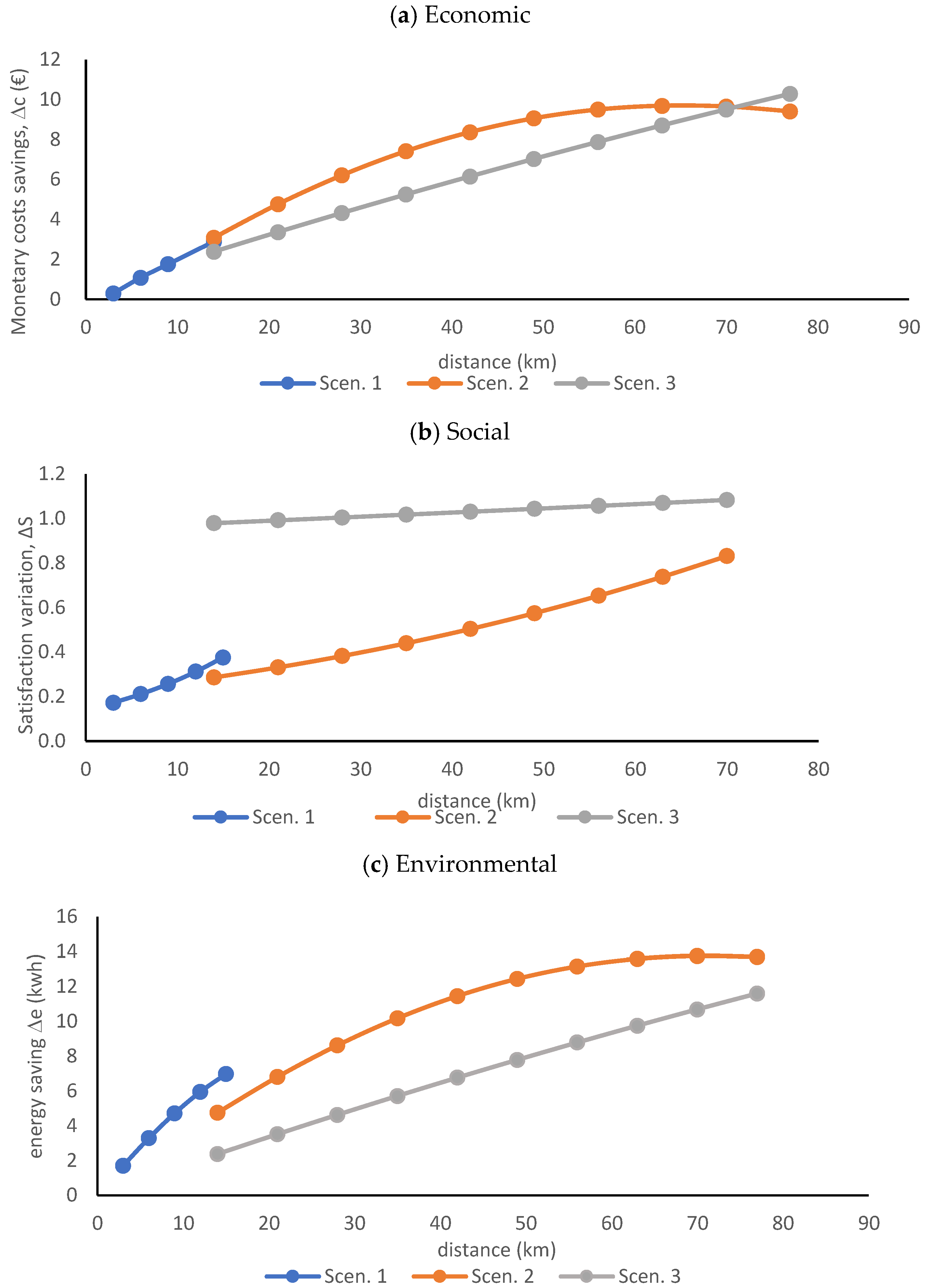
- sc is satisfaction, for a single trip, with a private car;
- ss is satisfaction, for a single trip, with the available alternatives included in MaaS and weighed against preference probability.
- ec is the energy consumption, for a single trip, in car mode;
- es is the energy consumption, for a single trip, with the available alternatives included in MaaS and weighed with respect to preference probability.
5. Discussions
6. Conclusive Remarks and Future Perspectives
Author Contributions
Funding
Data Availability Statement
Conflicts of Interest
References
- Hensher, D.A. Understanding Mobility as a Service (MaaS): Past, Present and Future; Elsevier: Amsterdam, The Netherlands; Cambridge, MA, USA, 2020; ISBN 978-0-12-820044-5. [Google Scholar]
- Alyavina, E.; Nikitas, A.; Njoya, E.T. Mobility as a Service (MaaS): A Thematic Map of Challenges and Opportunities. Res. Transp. Bus. Manag. 2022, 43, 100783. [Google Scholar] [CrossRef]
- Cirianni, F.M.M.; Comi, A.; Quattrone, A. Mobility Control Centre and Artificial Intelligence for Sustainable Urban Districts. Information 2023, 14, 581. [Google Scholar] [CrossRef]
- Reck, D.J.; Hensher, D.A.; Ho, C.Q. MaaS Bundle Design. Transp. Res. Part Policy Pract. 2020, 141, 485–501. [Google Scholar] [CrossRef]
- United Nation. UN Sustainable Development Goals (SDG). Available online: https://sdgs.un.org/goals (accessed on 7 May 2023).
- Comi, A.; Russo, F. Emerging Information and Communication Technologies: The Challenges for the Dynamic Freight Management in City Logistics. Front. Future Transp. 2022, 3, 887307. [Google Scholar] [CrossRef]
- Butler, L.; Yigitcanlar, T.; Paz, A. Barriers and Risks of Mobility-as-a-Service (MaaS) Adoption in Cities: A Systematic Review of the Literature. Cities 2021, 109, 103036. [Google Scholar] [CrossRef]
- Maas, B. Literature Review of Mobility as a Service. Sustainability 2022, 14, 8962. [Google Scholar] [CrossRef]
- Ho, C.Q.; Hensher, D.A.; Reck, D.J.; Lorimer, S.; Lu, I. MaaS bundle design and implementation: Lessons from the Sydney MaaS trial. Transp. Res. Part A: Policy Pract. 2021, 149, 339–376. [Google Scholar] [CrossRef]
- Russo, F. Sustainable Mobility as a Service: Dynamic Models for Agenda 2030 Policies. Information 2022, 13, 355. [Google Scholar] [CrossRef]
- Hensher, D.A.; Hietanen, S. Mobility as a Feature (MaaF): Rethinking the Focus of the Second Generation of Mobility as a Service (MaaS). Transp. Rev. 2023, 43, 325–329. [Google Scholar] [CrossRef]
- Alonso-González, M.J.; Hoogendoorn-Lanser, S.; Van Oort, N.; Cats, O.; Hoogendoorn, S. Drivers and Barriers in Adopting Mobility as a Service (MaaS)—A Latent Class Cluster Analysis of Attitudes. Transp. Res. Part Policy Pract. 2020, 132, 378–401. [Google Scholar] [CrossRef]
- Hauslbauer, A.L.; Verse, B.; Guenther, E.; Petzoldt, T. Access over Ownership: Barriers and Psychological Motives for Adopting Mobility as a Service (MaaS) from the Perspective of Users and Non-Users. Transp. Res. Interdiscip. Perspect. 2024, 23, 101005. [Google Scholar] [CrossRef]
- Deakin, M. Creating Smart-Er Cities; Routledge: London, UK, 2013; ISBN 978-1-317-98117-6. [Google Scholar]
- Musolino, G. Sustainable Mobility as a Service: Demand Analysis and Case Studies. Information 2022, 13, 376. [Google Scholar] [CrossRef]
- Davis, F.D. Perceived Usefulness, Perceived Ease of Use, and User Acceptance of Information Technology. MIS Q. 1989, 13, 319. [Google Scholar] [CrossRef]
- Campisi, T.; Basbas, S.; Skoufas, A.; Akgün, N.; Ticali, D.; Tesoriere, G. The Impact of COVID-19 Pandemic on the Resilience of Sustainable Mobility in Sicily. Sustainability 2020, 12, 8829. [Google Scholar] [CrossRef]
- Cascetta, E. Transportation Systems Engineering Theory and Methods; Springer Science & Business Media: Berlin, Germany, 2013; ISBN 978-1-4757-6873-2. [Google Scholar]
- Discrete Choice Analysis: Theory and Application to Travel Demand; Transportation studies; The MIT Press: Cambridge, MA, USA, 2018; ISBN 978-0-262-53640-0.
- Franco, A.; Vitetta, A. Preference Model in the Context of Mobility as a Service: A Pilot Case Study. Sustainability 2023, 15, 4802. [Google Scholar] [CrossRef]
- Birgillito, G.; Rindone, C.; Vitetta, A. Passenger Mobility in a Discontinuous Space: Modelling Access/Egress to Maritime Barrier in a Case Study. J. Adv. Transp. 2018, 1–3. [Google Scholar] [CrossRef]
- Musolino, G.; Rindone, C.; Vitale, A.; Vitetta, A. Pilot Survey of Passengers’ Preferences in Mobility as a Service (MaaS) Scenarios: A Case Study. Transp. Res. Procedia 2023, 69, 328–335. [Google Scholar] [CrossRef]
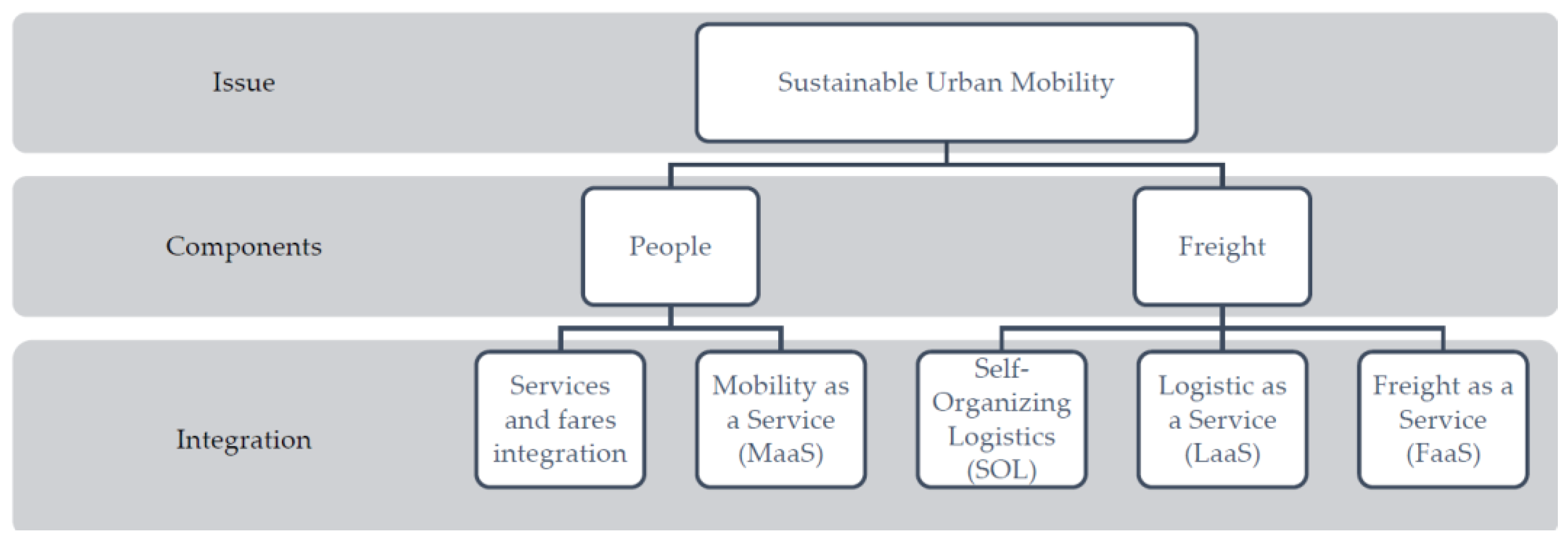

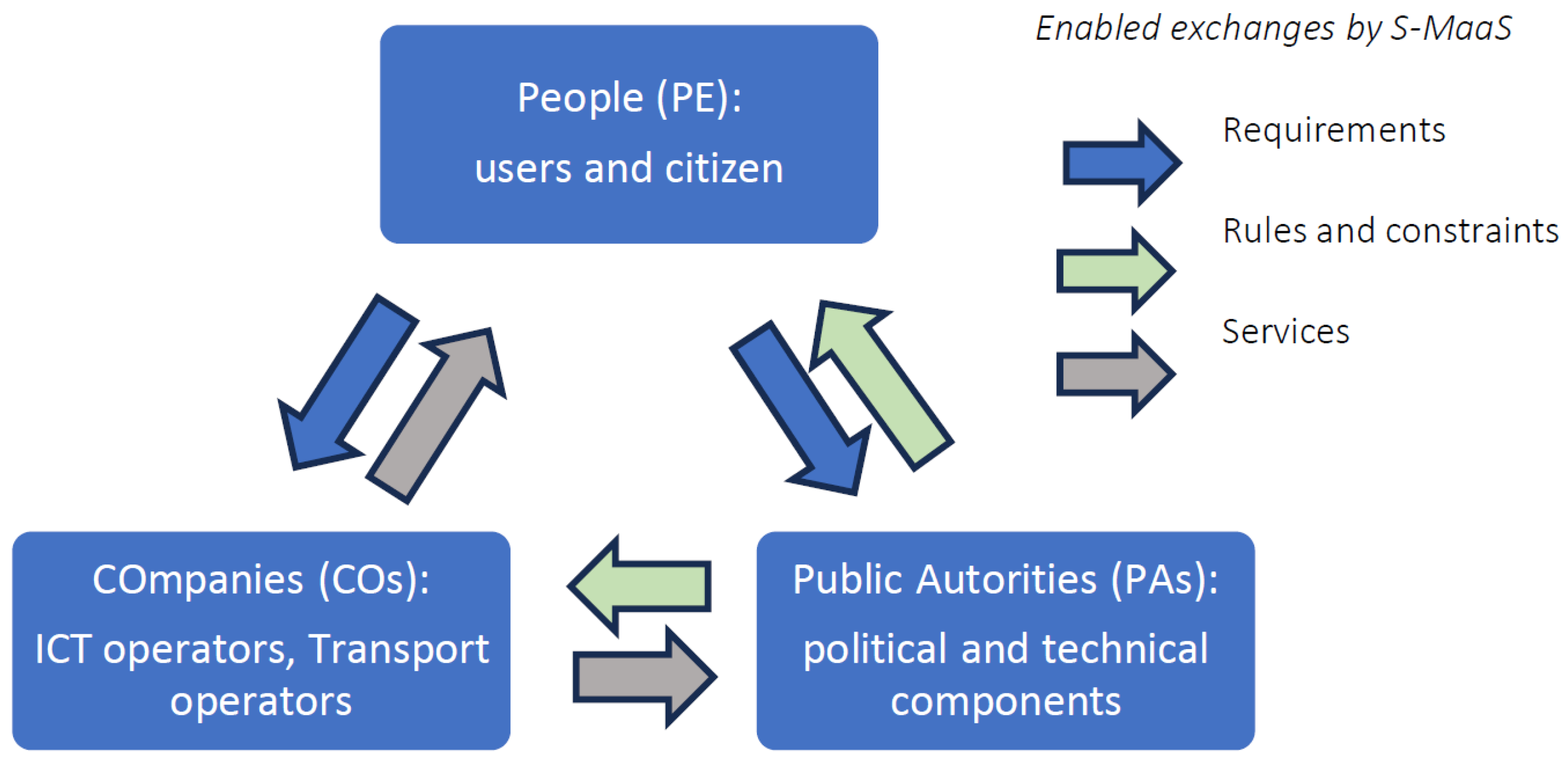
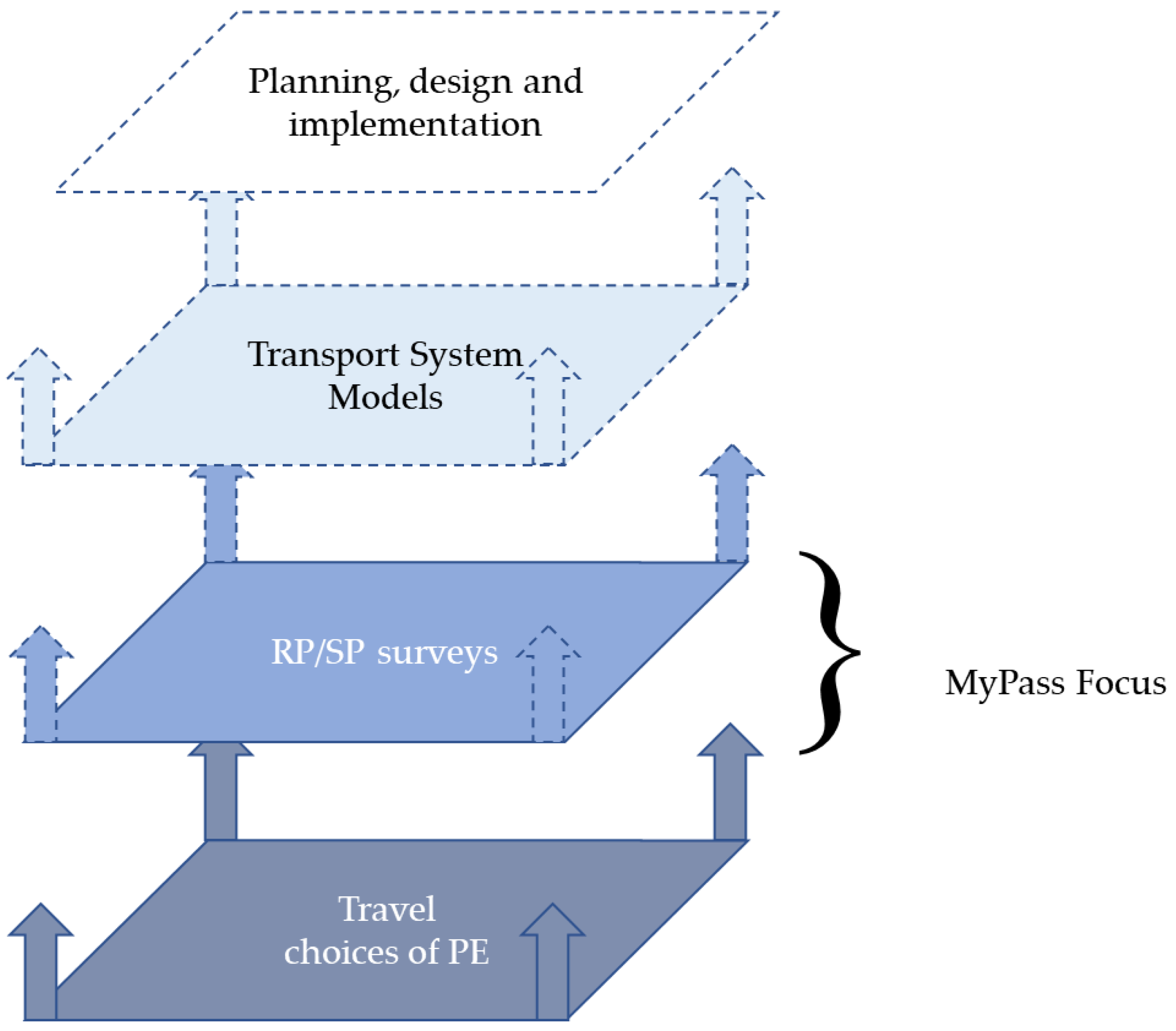

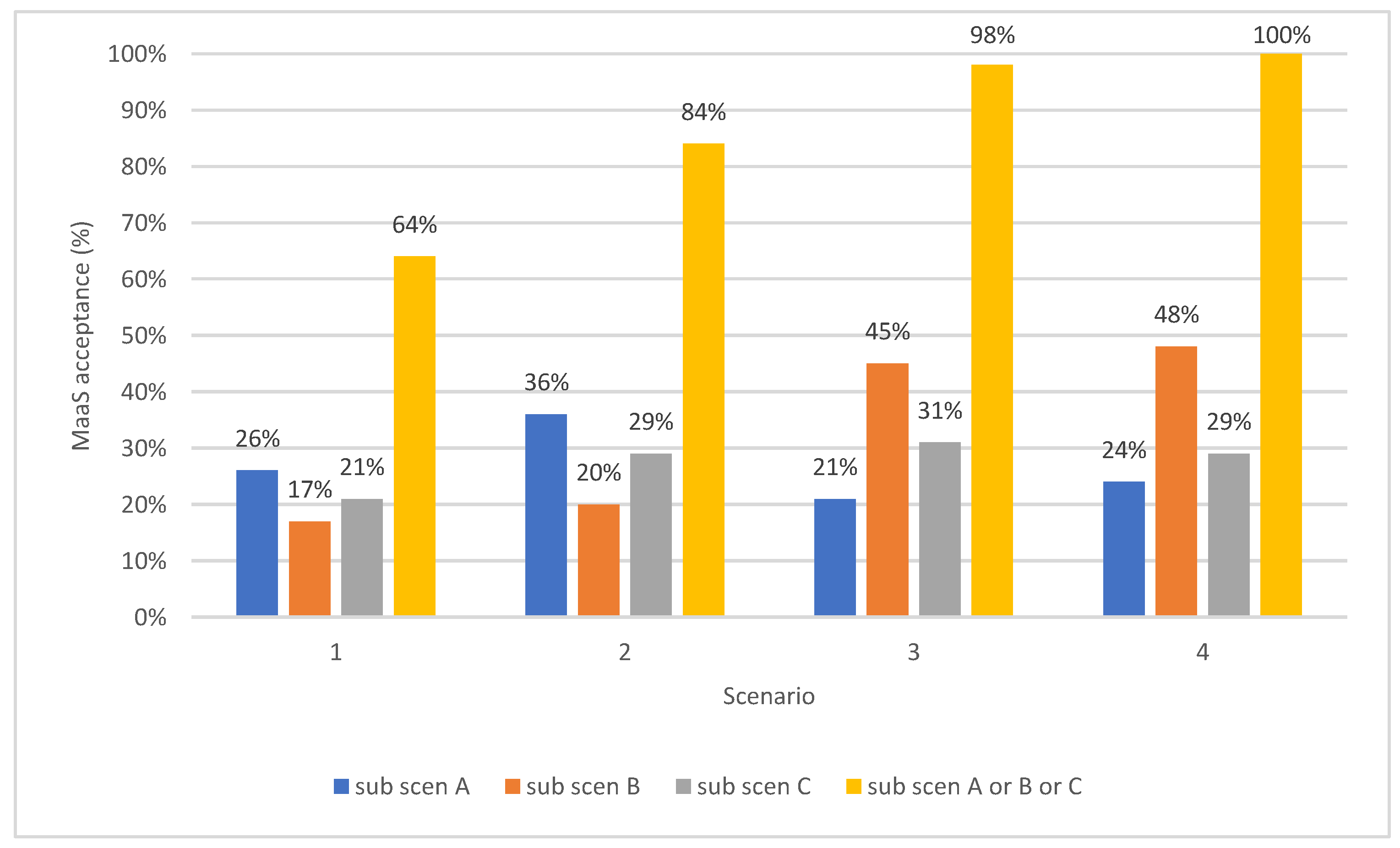
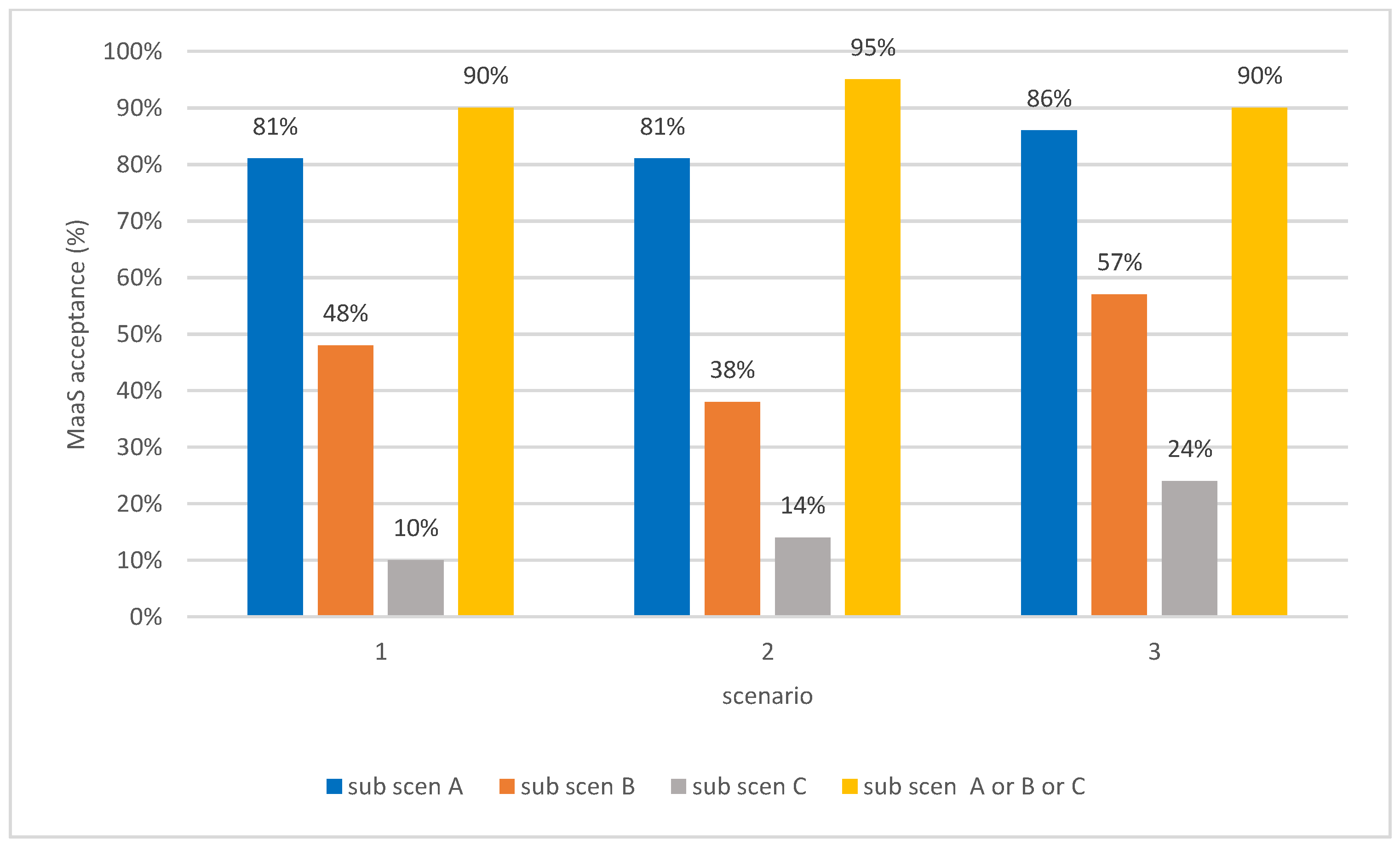
| Messina Strait | Gioia Tauro Area | |
|---|---|---|
| Territorial characteristics | Discontinuous land (barrier for mobility) Two metropolitan cities, minimum aerial distance of 4 km Residents: 1,000,000 inhabitants Surface: 2000 km2 | Continuous land 33 towns in 50 km Residents: 150,000 inhabitants Surface: 1000 km2 |
| Transport services characteristics | Road services (car sharing, bike sharing; urban, regional, and national bus services) Rail services (regional and national) Maritime services (high speed and ro-ro) Air services (national) Bike and car sharing | Road services (car sharing, bike sharing; urban, regional, and national bus services) Rail services (regional and national) |
| Section | Scenario | Information | ||
|---|---|---|---|---|
| I—User characteristics | PRESENT | Age, profession, number of household members, vehicle availability, type of vehicle ownership, number of vehicles owned in the household | ||
| II—Current travel characteristics (RP) | Origin, destination, hours, frequency, purpose, mode | |||
| III –MaaS potential travel characteristics (SP) | Scenario | sub-scenarios | Included services in the bundle | |
| 1, 2, 3, 4 MESSINA Strait | 1A, 1B, 1C: Mainland, without parking cost 2A, 2, 2C: Mainland, with parking cost | Taxi, bike sharing, car sharing, train, urban bus, extra-urban bus | ||
| 3A, 3B, 3C: Strait, with car 4A, 4B, 4C: Strait, without car | High-speed and ro-ro maritime services | |||
| 1, 2, 3 GIOIA TAURO Area | 1A, 1B, 1C: Urban | Bike sharing, car sharing, dial and ride, urban bus | ||
| 2A, 2B, 2C: Extra-urban, without parking cost 3A, 3B, 3C: Extra-urban, with parking cost | Included services in the bundle: bike sharing, car sharing, train, urban bus, extra-urban bus | |||
Disclaimer/Publisher’s Note: The statements, opinions and data contained in all publications are solely those of the individual author(s) and contributor(s) and not of MDPI and/or the editor(s). MDPI and/or the editor(s) disclaim responsibility for any injury to people or property resulting from any ideas, methods, instructions or products referred to in the content. |
© 2024 by the authors. Licensee MDPI, Basel, Switzerland. This article is an open access article distributed under the terms and conditions of the Creative Commons Attribution (CC BY) license (https://creativecommons.org/licenses/by/4.0/).
Share and Cite
Rindone, C.; Vitetta, A. Measuring Potential People’s Acceptance of Mobility as a Service: Evidence from Pilot Surveys. Information 2024, 15, 333. https://doi.org/10.3390/info15060333
Rindone C, Vitetta A. Measuring Potential People’s Acceptance of Mobility as a Service: Evidence from Pilot Surveys. Information. 2024; 15(6):333. https://doi.org/10.3390/info15060333
Chicago/Turabian StyleRindone, Corrado, and Antonino Vitetta. 2024. "Measuring Potential People’s Acceptance of Mobility as a Service: Evidence from Pilot Surveys" Information 15, no. 6: 333. https://doi.org/10.3390/info15060333
APA StyleRindone, C., & Vitetta, A. (2024). Measuring Potential People’s Acceptance of Mobility as a Service: Evidence from Pilot Surveys. Information, 15(6), 333. https://doi.org/10.3390/info15060333







